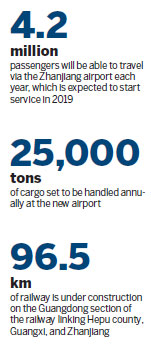Transport projects see steady progress
Zhanjiang, Guangdong province, saw breakthrough progress last week in various projects to upgrade the city's transport network. The projects are aimed to enable greater regional economic integration.
Preliminary surveys were launched in Wuchuan, a county-level city in the region, at a site that will house the relocated Zhanjiang airport. It is the only airport in western Guangdong.
The site is located 32 kilometers away from Zhanjiang's urban area and 38 km from the urban area of Maoming, another city in western Guangdong.

The airport is designed to handle 4.2 million passengers and 25,000 metric tons of cargo annually. According to Guangdong Airport Management Group, the new airport is scheduled to begin operation in 2019. The current airport served more than 1.2 million passengers last year.
Work also started on the 96.5 km Guangdong section of the railway linking Hepu county in the Guangxi Zhuang autonomous region and Zhanjiang. Rail services on the line are due to start in 2021.
The railway, bringing the travel time between Nanning, capital of Guangxi, and Zhanjiang down from six hours to two hours, is set to promote the integration of Zhanjiang into the Beibu Bay Economic Rim. The Zhanjiang government has set the goal of becoming a central city in the rim.
Construction of the Zhanjiang section of the expressway between Yulin, Guangxi, and Zhanjiang has also started, significantly reducing driving time between the cities.
Work was also launched on another expressway connecting Zhanjiang's high-speed railway station with the center of the city.
The high-speed railway, l inking Zhanjiang and Guangzhou, capital of Guangdong, is expected to open to traffic in 2018, according to the city's development and reform commission.
The relocation of Guangdong Zhanhua Group, a large-scale chemical fertilizer manufacturer, to Donghai Island was also carried out last week. Officials expect the move to generate revenue of 4.2 billion yuan ($604.6 million) annually after the new site comes into operation in 2018.
(China Daily 12/27/2016 page11)



 Print
Print Mail
Mail

